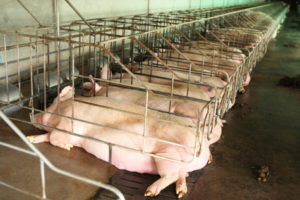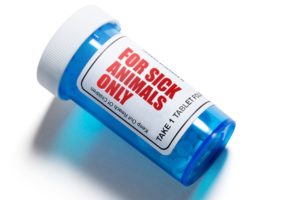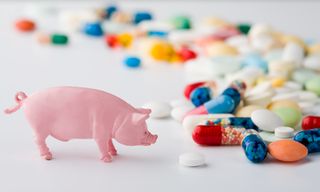Across media outlets this week the world heard of scientifically verified fact that antibiotics in livestock supplies are leading us towards a global health crisis. While the systemic plague of the overuse of antibiotics is across all species raised for food production, the most recent study published in the journal mBio focused on swine. Researchers looked at large swine populations in the United States and China and found that resistant genes and mobile genetic genes were forming together. Translation: the overuse of antibiotics in animal production is causing resistant strains to develop and spread, putting the entire world’s human population at serious risk.
Antibiotics keep animals healthy, and help prevent disease from entering into our supply chain. No one can argue against the important of animal welfare and food safety. Here is  the shocker: a common use of antibiotics in domestic swine production in the United States is referred to as subtherapeutic, doses that animals are given to increase weight. The dosing is ongoing and weight can increase up to three percent. Yes, in case you are wrapping your head around this let’s use layman’s terms. Antibiotics are given to healthy animals to fatten them up. The similarity between human antibiotics and those we feed livestock to increase their weight causes the evolution of antibiotic-resistant bacteria strains by swine to be a serious public health threat.
the shocker: a common use of antibiotics in domestic swine production in the United States is referred to as subtherapeutic, doses that animals are given to increase weight. The dosing is ongoing and weight can increase up to three percent. Yes, in case you are wrapping your head around this let’s use layman’s terms. Antibiotics are given to healthy animals to fatten them up. The similarity between human antibiotics and those we feed livestock to increase their weight causes the evolution of antibiotic-resistant bacteria strains by swine to be a serious public health threat.
This practice of beefing pigs up with subtherapeutic antibiotics, STA, isn’t new. Pennies on the pound can make a real difference in pork sales where profit margins can be slim. Because of the potential catastrophic outcome of STAs, subtherapeutic use of antibiotics has been banned in Europe for over a decade. Legislation in the U.S. has been under consideration for years. Once again, cheap food turns out to be quite expensive. Antibiotic resistant bacteria caused $20 billion dollars in health care costs in the U.S., and that was just last year. No one denies the need for quality safe food, but ultimately, the desire for profit blatantly disregards what many scientists have known for decades, that a health crisis is looming.
The overuse of antibiotics is prolific in agriculture, in subtherapeutic use, but also as preventatives rather than as a treatment. Over 70% of the antibiotics produced in the U.S. are used in animal production. Antibiotics are regulated to ensure that they mostly leave an animal before consumption, and where do they go? Every year in America almost two trillion tons of animal waste are produced. These two trillions tons are filled with both antibiotics and the resistant bacteria that “subtherapeutic” doses and overuse of preventative antibiotics have caused.
Under public pressure even poultry goliaths such Tyson Foods, Perdue Farms and Foster Farms, are reducing their use in preventative and growth antibiotic use. Consumers vote with their wallets and increased awareness is causing farms of all shapes and sizes to reconsider the externalities of their business decisions.
 Antibiotics should be used, but on sick animals, not as preventative, and definitely not to fatten animals up. Subtherapeutic use of antibiotics has been banned in Europe and Canada resulting in a decrease in disease resistance and still a healthy livestock population. But, here in the U.S. we shamefully continue this profit-guided travesty. Why do we do this when a significant study following the ban in Europe found that prices only went up five cents a pound? Even if the price went up twenty times that, it would still come nowhere near the cost in human life and hundreds of billions of dollars in long run healthcare costs.
Antibiotics should be used, but on sick animals, not as preventative, and definitely not to fatten animals up. Subtherapeutic use of antibiotics has been banned in Europe and Canada resulting in a decrease in disease resistance and still a healthy livestock population. But, here in the U.S. we shamefully continue this profit-guided travesty. Why do we do this when a significant study following the ban in Europe found that prices only went up five cents a pound? Even if the price went up twenty times that, it would still come nowhere near the cost in human life and hundreds of billions of dollars in long run healthcare costs.
The Preservation of Antibiotics for Medical Treatment Act (PAMTA) would prevent eight commonly used human class antibiotics from being used to promote weight gain and reserve them to be only used on sick animals. This legislation was introduced in 1999 when other nations around the world agreed that action needed to be taken. Despite the industry fight against common sense, this legislation was reintroduced to Congress last year and has a whopping 78 co-sponsors as well as widespread support across the country from the health, environmental, religious, consumer advocate, and animal rights groups. The originator of this bill, Rep. Louise Slaughter (D-NY) said, “If we want to prevent a nightmarish post-antibiotic future, citizens of this country need to speak up and demand that their leaders enact enforceable, verifiable limits on the use of antibiotics on the farm.”
When you go to any major grocery store and find a large ham for under a dollar a pound, there is a problem. Cheap pork pumped up with antibiotics is killing us. This is fact, not conspiracy, but scientifically confirmed fact. It is time to ban subtherapeutic antibiotic use. The costs by far outweigh the financial benefit to a small number of individual producers. Cheap food saves pennies now, followed by billions in healthcare costs. The truth is out, the science is there, and we do not need more of the usual, “There is not enough conclusive evidence…”, antibiotics used to promote growth is an unnecessary practice that should be universally condemned. As a country with global influence, America should proudly ban this dangerous practice that is seriously eroding our health security.



